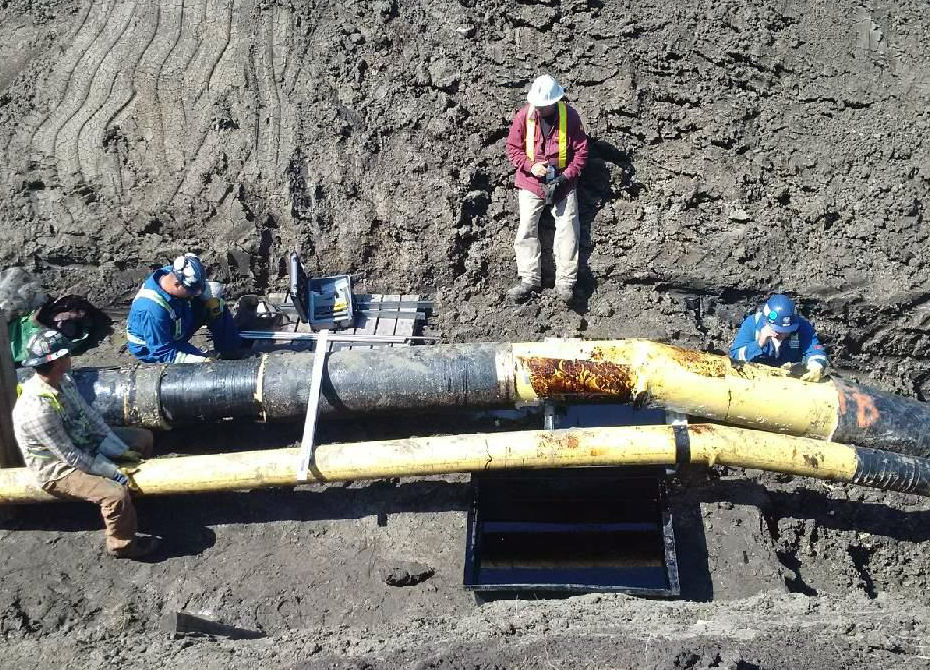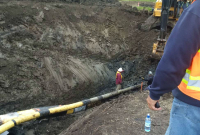Support strong Canadian climate journalism for 2025
A year after a major oil spill along the North Saskatchewan River fouled the water source for three Saskatchewan cities, an environmentalist says the company involved should get more than just "a slap on the wrist."
Peter Prebble with the Saskatchewan Environmental Society says he hopes Husky Energy will be held to account after one of its pipelines leaked 225,000 litres of heavy oil mixed with diluent onto the riverbank near Maidstone, Sask. About 40 per cent of the spill reached the river.
The oil plume flowed hundreds of kilometres downstream and forced the cities of North Battleford, Prince Albert and Melfort to shut off their water intakes for almost two months.
Saskatchewan’s Ministry of Justice isn’t commenting. It is still reviewing Husky’s response to alarms before the spill to decide whether charges should be laid.
"If it was just a matter of deciding on a fine, then I would think it wouldn’t be all that complicated at this point in time," said Prebble.
"If the department is actually working on a larger settlement that involves upgrades to the safety of the oil pipeline system that Husky operates in the province, then that’s something that could take more time," he said. "If we don’t see that, I’ll be really concerned because Husky is a big company and the fine could just end up being a slap on the wrist."
Husky could face fines of up to $1 million a day under the Environmental Protection Act and $50,000 a day under the Pipelines Act in Saskatchewan.
There could also be federal charges under the Fisheries Act, said Dale Marshall, national program manager with the group Environmental Defence.
"It remains to be seen whether fines will be levied or not," said Marshall, noting he would be surprised if they weren’t.
Marshall said it often takes more than a year for charges. He suggested they should be laid more quickly "in the interest of accountability and to send a clear message to other pipeline operators and oil companies that these matters are taken seriously and will be dealt with quickly."
Marshall noted it took a couple of years before charges were laid in spills in Alberta.
Earlier this month, the Alberta Energy Regulator laid five charges against Nexen Energy (TSX:NXY) for a pipeline spill two years ago that was one of the largest in provincial history.
In June 2014, Plains Midstream Canada was fined $1.3 million after pleading guilty to environmental charges related to two spills: one in April 2011 and the other in June 2012.
In Saskatchewan, the statute of limitations for charges under The Environmental Management and Protection Act is three years. Marshall couldn’t say why it takes so long.
"There’s almost no doubt that if charges are laid, they will be determined through some sort of negotiation with the oil industry. I think that’s almost a given. They’ll have certain charges that will be laid in exchange for a guilty verdict."
Part of the concern in the Husky spill is over how it was reported.
The government was first told by a member of the public who spotted oil on the river — not Husky. Government investigators later determined that the leak began July 20, the day before the spill was discovered.
They found that the pipeline’s alarms were warning of potential problems and continued until the line was shut down for scheduled maintenance at 7:15 a.m. on July 21. Husky Energy has said pipeline monitoring indicated pressure anomalies at 8 p.m. on July 20 and the company started a shutdown at 6 a.m.
Husky’s own investigation determined that the pipeline buckled because of ground movement. The company has said it accepts full responsibility and is using what it learned to improve operations.
Prebble said Husky should be required to install the latest spill detection technology, have automatic pipeline shutoff valves and install heavier walled pipes at river crossings.
"Those kind of measures are going to be important requirements."
Here’s a list of some spills of oil and other materials on the Prairies in recent years:
January 2017: A band member from the Ocean Man First Nation in southeastern Saskatchewan finds a 200,000−litre pool of crude on farmland. The pipeline responsible, owned by Tundra Energy Marketing, is nearly 50 years old and there’s no record of it ever being inspected by provincial authorities.
June 2016: An estimated 380,000 litres of light petroleum leaks within five kilometres of a grizzly bear management zone in northwestern Alberta. Owners ConocoPhillips Canada and Paramount Resources say the leak of condensate, a liquid produced with natural gas, is from a gas plant near Grande Cache, Alta. No one is found living in the area and there’s no evidence of animals or fish hurt by the spill.
July 2015: Five million litres of bitumen, sand and water mixed together spill into muskeg at Nexen Energy’s Long Lake oilsands project near Fort McMurray, Alta. The company concludes a pipeline rupture went undetected for about a month before it was discovered by a contractor. Nexen says the pipeline was not designed properly for muskeg conditions. In July 2017, the Alberta Energy Regulator lays five charges against Nexen.
March 2015: About 2.7 million litres of condensate used to dilute heavy oil is discovered near the muskeg’s surface at Murphy Oil’s heavy oil site, 80 kilometres northeast of Peace River, Alta. The company says the spill occurred over an extended time period. No harm to wildlife is reported.
November 2014: Canadian Natural Resources says a mechanical failure led to a spill of 60,000 litres of crude oil near Red Earth Creek in northern Alberta. The company says most of the spill was contained on the company’s land and a nearby pipeline right of way. No report of harm to wildlife.
April 2014: A pipeline owned by Canadian Natural Resources spills 70,000 litres of oil and processed water northwest of Slave Lake, Alta. The spill is described as not being near any people, water or wildlife.
July 2013: Canadian Natural Resources identifies four sites where a bitumen−water mix has been seeping from an old well at the company’s oilsands project on the Cold Lake Air Weapons Range. At least 1.5 million litres of bitumen is recovered. At least 100 animals die. The Alberta government issues environmental protection orders and limits the amount of steam CNRL pumps into the reservoir.
May 2013: An Apache Canada pipeline in the Zama City region of northern Alberta leaks 15 million litres of process water heavily contaminated with salt. Another 1.8−million−litre leak of waste water is discovered the following October.
June 2012: Some 461,000 litres of oil from a Plains Midstream pipeline leaks into a tributary of the Red Deer River in central Alberta from an underwater pipe cracked by high water flows. Gleniffer Lake, a man−made reservoir popular with water recreationists, is closed for nearly three weeks. A marina and campground are also closed, fishing on the river is shut down and drinking water is trucked in. The province’s regulator concludes the line had not been adequately inspected.
May 2012: A leak that goes undetected for days from a Pace Oil and Gas waste disposal line releases about 800,000 litres of light sweet oil near Rainbow Lake close to the Alberta−Northwest Territories boundary. It is discovered when an aircraft from another oil company makes a routine flyover.
April 2011: A poorly welded and highly stressed section of the Rainbow pipeline owned by Plains Midstream cracks and spews about 4.5 million litres of oil into low−lying marshland near the northern Alberta aboriginal community of Little Buffalo. A beaver dam prevents oil from spreading beyond the spill site. School in Little Buffalo is cancelled for several days over odour concerns. Damage is described in court as significant.
April 2007: A rupture in a pipeline belonging to Enbridge Pipelines downstream of a pump station near Glenavon, Sask., spews about 990,000 litres of crude oil into a wetland on farmland. About 912,000 litres is recovered. There are no injuries.





Comments